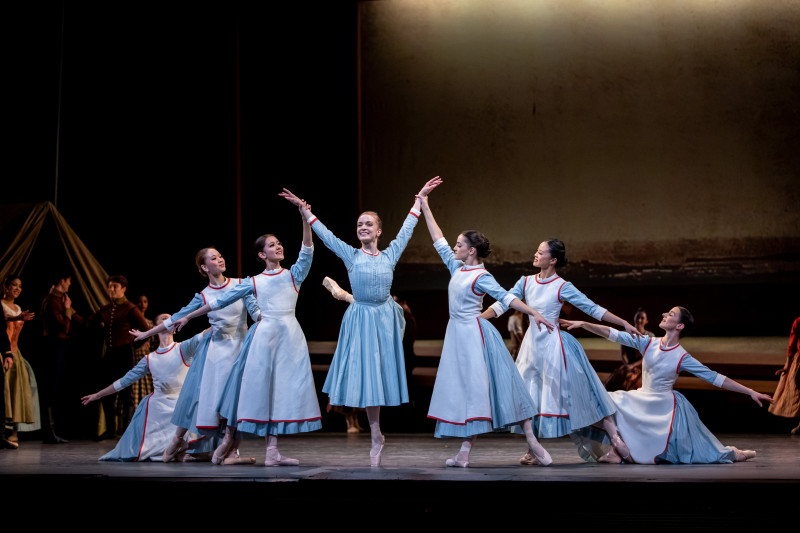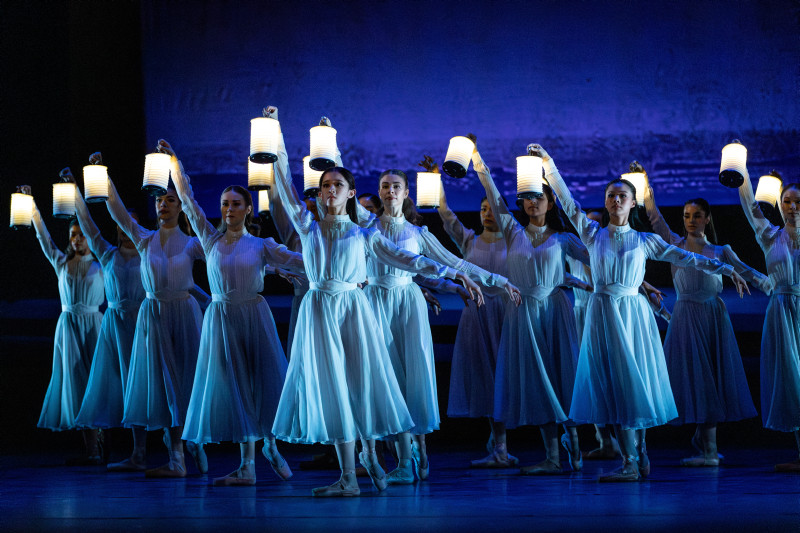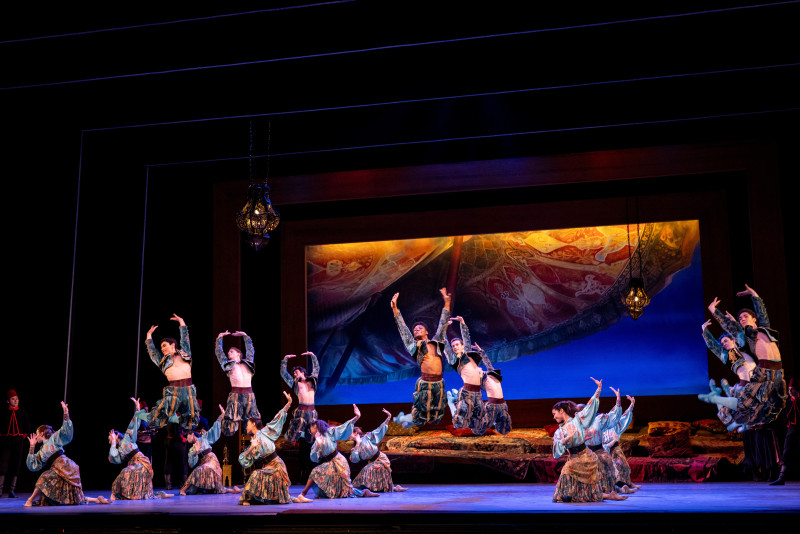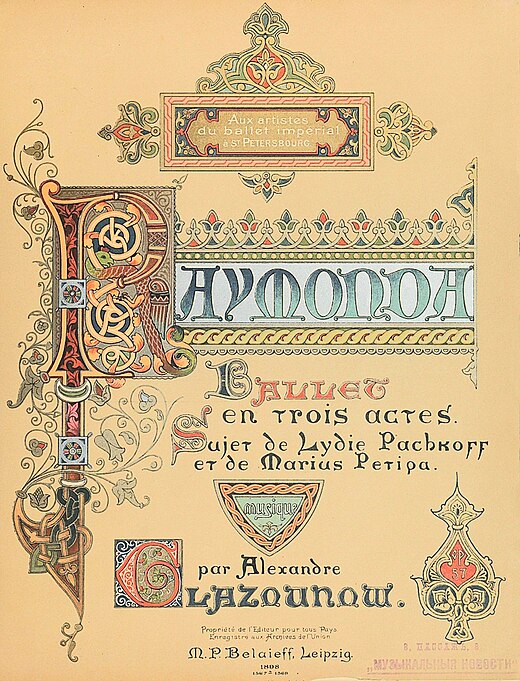Marius Petipa’s 1898 classic, Raymonda, has long been due for a reboot. Set during the Crusades, it features a courtly knight and his betrothed, the helpless but beautiful Raymonda. In this current Bolshoi staging, the gallant Jean de Brienne heads off to fight the infidels, leaving Raymonda to fend for herself (or not) against a nefarious Saracen who is dazzled by her beauty and yearns to possess her. Growing more aggressive, he ultimately resorts to an abduction that gets thwarted when our hero, Jean, returns just in time to rescue her and kill the bad guy. Their wedding follows, everyone dances, and that’s that.
Yeah. Not going to fly in 2025.
San Francisco Ballet’s artistic director Tamara Rojo has long agreed, and began to re-imagine a more relevant staging in 2021, while still artistic director of the English National Ballet. Following its London premiere in 2022, she was happy to bring the ballet with her to San Francisco when taking her position as the company’s new artistic director. “Marius Petipa’s original Raymonda is not only rarely seen in the U.S., but it is never performed in its entirety, which made creating this piece a rich and choreographic challenge for me,” she shared in the program notes. Judging by the engaged, enthusiastic crowd last Sunday afternoon at the War Memorial Opera House, this Raymonda works very well indeed.
In Rojo’s reimagining, the action takes place in the 1850’s during the Crimean War. Raymonda is an intelligent, spirited young woman, not content with the status quo of a Victorian-era upper-class female (“marry well or … marry well”). Jean de Brienne is now John de Bryan, a family friend who visits her household, announcing his departure for the front line, prompting Raymonda to consider, then act on her own calling, much in the way of Florence Nightingale, from whom Rojo drew inspiration for her Raymonda.

Alexander Glazunov’s music, adapted and edited by Gavin Sutherland and Lars Payne, is one of the ballet’s gems, every bit as lush and romantic as a Tchaikovsky ballet score. Another perfect fit was the use of Alexander Gunnarsson’s video projections of the day’s newspaper headlines, (“Conflict Intensifies” and “War Declared” and “British Nurses Step In”), one peeling off after the next, a rapid-fire dissemination of information both helpful and aesthetically pleasing. Another projection succinctly chronicled Raymonda’s journey via a moving map, charmingly reminiscent of an Indiana Jones film, and like that, Raymonda and the audience arrive in the port city of Sevastopol, Ukraine, where the curtain rises, crowds swarm the stage, and we are in the thick of things. The scene is lively, lots of dancing and camaraderie, great ensemble work and close-ups on John (Wei Wang)and his friends (Luca Ferrò and Lucas López) and Raymonda (Wona Park) with hers (Isabella DeVivo as Henriette and Jennifer Stahl as Sister Clemence). Excellent dancing abounds; really, I can’t point out one place where the dancers were less than sublime. Particularly impressive was the unison dancing, right on the money, time after time. The men’s jumps in particular. Wow, so airborne, so clean, so much fun to watch, and it seemed like the dancers were enjoying themselves, too, clad in Antony McDonald’s colorful, varied costumes.
Act I delivers a lot of story, and within its fifty-plus minutes, Raymonda is reunited with John, meets his friend Abdur Rahman, an Ottoman prince and officer, accepts John’s marriage proposal, watches with alarm as a scuffle ensues amid the Ottoman and British soldiers. There’s chaos as Raymonda tries to tend to the patients, only to fall while running. It’s Abdur who notices and helps her up, and in a flash, there’s chemistry that disorients them both. John, unaware, announces he and his comrades are off to fight and, turning to Abdur, asks that he watch over Raymonda.
Careful what you ask for.

A dream scene later in Act I includes some of the loveliest ensemble dancing of the night, as a host of nurses bearing lamps (à la Florence Nightingale who was also known as “the lady with the lamp”) gather in rows and dance amid a ghostly semidarkness, their lamps like giant fireflies. Later, a pas de deux—still part of the dream—between John and Raymonda hints to their lack of connection. He reaches for her hand but misses it, and dances around her, anguished and conflicted, until finally she rouses herself from her torpor and dances with him, only to step one way as he steps the other. This frequent misstep of theirs was a great vehicle for showing how, really, they weren’t aligned as a couple, and yet they politely and dutifully continued to try.
I was less smitten with the arrival of six soldiers coming down an upstage ramp, a graceful step, step, pause and arch back, which was repeated, a new soldier appearing each time, and it seemed like a weird echo of the Shades’ entrance in the iconic “Kingdom of the Shades,” arguably classical ballet’s most stunning ensemble dance. I’m guessing the resemblance was intentional, perhaps a play on gender expectation, but it seemed almost parody. I was relieved when it stopped at six men, and the rest was lovely, affecting, the men pairing with the nurses, where even here war intruded, as men would lurch forward, chests out, perfectly mimicked being shot on the battlefield. It was poignant, unforgettable.
I couldn’t have asked for better performances from Wei Wang as John and Wona Park as Raymonda. Both seemed to be having a fantastic afternoon, strong and consistent, technically rock-solid and soft, vulnerable, when the story called for it. But Act II, and in some ways the whole ballet, belonged to Esteban Hernández as Abdur Rahman, who has invited Raymonda and her friends to a party at his tent.

Hernández took “excellent” and dialed it up a notch. Taking absolute control of the stage, the scene, he exuded a commanding strength, in his arms, his bearing, and leaps with a chest-thump, head thrown back. I’ve never seen him dance better, certainly not with this kind of power and presence, which the role demanded—he’s representing the spirit of the nefarious Saracen, after all. The pas de deux between him and Raymonda positively sizzled, both of them coming to life in new ways. But then the party was interrupted as John and his men returned, wounded, exhausted, demoralized. As John slumped to the floor, you understood that suddenly Raymonda had a difficult decision to make.
Yet one more act with yet more vivid dancing with big ensembles, making use of the company’s big roster of talented males and females alike, almost started to feel like too much of a good thing, even as the colorful characters and dances (like in Act II, choreographed by Vadim Sirotin) continued to beguile. At two hours and forty-five minutes, this is a long ballet. I had mixed feelings about the final moments and Raymonda’s ultimate choice and its impact, but I’ll that up to others to decide whether it worked for them or not.
Credit for this production and ballet must also include the music and its musicians. Kudos to Martin West and the San Francisco Ballet Orchestra for their silken rendition of Glazunov’s glorious score. A shout-out to the ensemble musicians who played the cimbalom (think: a Hungarian dulcimer), the violin and the clarinet (?) onstage in Act III, as well as a beautiful violin solo (Cordula Merks?) and an exquisite harp solo (Annabelle Taubl?). For my classical-music readers, or anyone who heard and loved the music, below is Glazunov’s score. Give it a listen.
Better yet, go see the ballet, then come home and give it a listen. You will remain enchanted with Raymonda.

I love this ballet and had the opportunity to see the English National Ballet perform it in 2022. Thank you for the link to the Bolshoi production. I have not seen that one.
You’re very welcome, Hermione! Thanks for commenting.